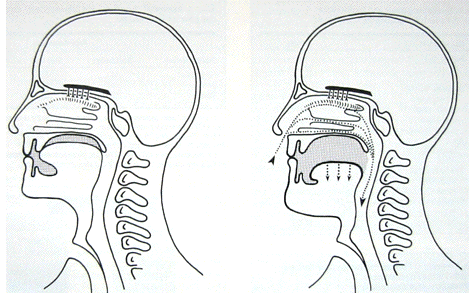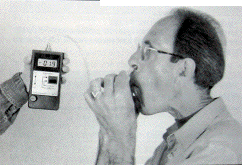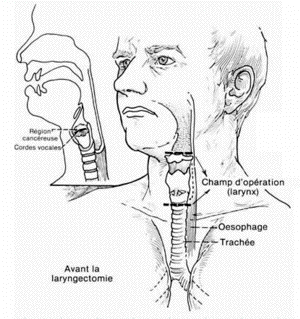- Although deterioration of olfaction after
total laryngectomy is reported by th majority of
patients, this unpleasant side effect ha not
received widespread attention. More over,
olfactory rehabilitation has been given much
less consideration than other more obvious
sequelae of this operation ie vocal and
pulmonary rehabilitation. In several overviews
on the "total rehabili tation of
laryngectomees," olfactory problems as a
consequence of the laryngectomy were not even
mentioned.It was thought that the anosima, noted
iminediately after the operation, was an
inevitable result of the laryngectomy and that
no return of olfactory acuity occurred as long
as 8 years after operation. Others however, have
reported improvement in olfaction during the
first 6 months after surgery and the presence of
a relatively normal sense of smeil in some
laryngectomees A recent study in our clinic
showed that patients who have undergone
laryngectomy could be divided into 2 groups on
the basis of an odor detection and/or an odor
differentiation test, ie, "smellers" and
"nonsmellers." These tests were performed
without artificial devices to generate a nasal
airflow. The results of these "natural" tests
indicated that one third of the patients could
be classified as smellers. This category of
patients reported not only a better sense of
smell than the nonsmellers but also a better
sense of taste and appetite.
-
- The consequences of the loss of the sense of
smell can be profound. Anosmia results, for
instance, in the loss of the signal function to
detect smoke or leaking gas. The inability to
detect bodily odors can cause insecurities in
daily life, and the inability to perceive
agreeable odors or fragrances can be experienced
as a significant loss. Since most so-called
tastes (eg,chocolate, coffee, tea, meat, etc)
are dependent on retronasal stimulation of the
olfactory receptors, the perception of such
tastes will also be negatively influenced by the
loss of the sense of smell.
-
- Although factors such as atrophy of the
olfactory neuroepithelium and/or bulb may also
play a role in the olfactory problems of
patients after laryngectomy, restoring nasal
airflow is a prerequisite for rehabilitation of
olfactory acuity in such patients.The main
reason for the lack of an adequate nasal airflow
is the disconnection of the upper and lower
airways. By creating an artificial airflow with
insufflation of the odors into the nose, using
squeeze bottles, other nebulizers or a so-called
larynx bypass, it became clear that in many
laryngectomees the sense of smell is more or
less preserved. However, because of their
artificial nature and cumbersome application in
daily life, these devices to restore nasal
airflow are not extensively used. Others have
described more unobtrusive methods to generate
some degree of nasal airflow by creating volume
changes in the pharynx with the mouth closed,
such as the buccopharyngeal maneuver,
buccopharyngeal sniffing, or glossopharyngeal
press, but these also are not widely
applied.
-
- In our previous study, the smellers
significantly more often had developed their own
technique to improve olfaction, such as
movements of the jaw and/or muscles in the face
and floor of mouth and mastication muscles. On
the basis of observations in our previous study
and on remarks by patients and partners, we
developed a nasal airflow-inducing maneuver
(NAIM) in which a repeated extended yawning
movement is performed, lowering the jaw,
floor of niouth, tongue, base of tongue, and
soft palate while keeping the lips securely
closed. This is easily taught to patients by
describing it as yawning with the mouth closed,
ie, "polite yawning." This maneuver induces a
negative pressure in the oral cavity and
oropharynx, which generates a nasal airflow,
enabling odorous substances to reach the
olfactory epithelium again.
-
- We describe an intervention study with this
NAIM to assess whether patients can acquire this
technique and whether it leads to an improvement
of olfactory acuity. [...]
-
 -
 - Loss of olfactory acuity after total
laryngectomy is a disturbing side effect of this
debilitating surgical procedure. The majority of
the patients report a complete loss of the sense
of smell. In an earlier study, using an ODT and
an odor differentiation test, we found that 32%
of the patients were still able to smell,
whereas 68% were unable to detect or
differentiate any of the odorous substances
offered in these tests. Patients who applied
some sort of personal technique to smell were
significantly more often successful in
accomplishing these olfactory tests. It also
became clear that the loss of olfaction from
total laryngectomy was not consistently
addressed during rehabilitation sessions.
-
- On the basis of the literature and
observations made during our previous study, a
NAIM was developed and tested in an intervention
study. To the best of our knowledge, this is the
first study to show a positive effect on the
olfactory acuity of patients after laryngectomy
by applying a special maneuver. The improvement
in a substantial number of the patients,
increasing the percentage of smellers from 25%
to 57% in this sample, is very promising.
Preservation of olfactory ability in patients
after laryngectorny by teaching the NAIM is thus
an attainable goal in postlaryngectomy
rehabilitation, as already postulated by
Schwartz et al, who used a buccopharyngeal
sniffing technique. Furthermore, it was
encouraging that most patients mastered the
"polite yawning" technique in one 30-minute
session. The patients easily understood the
description and demonstration of the technique
as a polite yawning movement.
-
- As demonstrated by the use of a water or a
digital manometer, the NAIM creates a negative
pressure in the oral and nasal cavity, thus
generating a nasal airflow. Using a comparable
method, Tatchell et al" found a nican volunie of
nasal airflow of 5.4 L/min, which is about 15%
of the norm. They also found that increasing the
nasal airflow, by using a laryngeal bypass,
increased the olfactory threshold and odor
discrimination. It could be demonstrated with
this artificial device that laryngectoinees,
although generating a slightly but significantly
lower an-flow, scored the saine as normal
controls. The method by which patients generated
a nasal airflow ni the study of Tatchell et al,
however, is somewhat unclear. They probably
applied some form of personalized technique of
buccopharyngeal sniffing but were nevertheless
able to generatea nasal air-flow. It can be
hypothesized fromvthe results of our study that
better and more consistent results can be
obtained by teaching the NAIM. The use of a
manometer is very helpful in this respect; the
simple water manometer, in particular, is an
inexpensive and easy to use tool in the
instruction of the NAIM during the
rehabilitation sessions.
-
- Because of the design of this intervention
study, with the use of preintervention and
postintervcntion olfaction assessments without
randornization for treatment or no treatment,
some placebo effect might be responsible for the
improvement found on the POPS. This might be
concluded from the improvements seen ni some of
the other QOTA scores (present compared with
past odor perception, and gustation) not only in
the smellers but also in the nonsmellers. The
attention given to their olfaction problem and
the identification of the smelling sticks during
the instruction of the NAIM might have given
some patients the idea that their sense of smell
was net as bad as they thought. However, the
results of the ODT are net prone to being
confounded by a placebo effect. The very stable
results in all tested variables (ODT and QOTA
scores) in the subset of patients who were
analyzed twice with an interval of 10 months can
also be considered an indication that the
effects mesured are a result of the intervention
and not caused by a placebo effect.
-
- An interesting observation was that patients
who clearly demonstrated an improved sense of
smell during testing, with the use of the NAIM,
still did net think that their olfaction was
improved. They often explained that they still
were unable to automatically smell odors in
their environment. This implies that patients
should be instructed to always use the NAIM when
entering a new room or environment and to repeat
the maneuver regularly to compensate for the
loss of passive smelling, always present during
normal nasopulmonary breathing or
sniffing.`Olfactory rehabilitation, therefore,
should focus not only on the maneuver itself,
but also on regular use of the technique during
the day, to mimic passive smelling. The present
results were obtained with only 1 therapy
session in the majority of patients. As with
other aspects of postlaryngectomy rehabilitation
(eg, voice and pulmonary status), olfactory
rehabilitation might benefit from early and
repeated attention. Others who might benefit
from this polite yawning technique
include quadriplegic patients receiving
permanent ventilation via a cuffed trachea
cannula. It is well known that these patients
also suffer from anosmia. Since their cranial
nerve function is intact, they should be able to
acquire this NAIM as well, thus improving their
olfactory acuity.
-
- It is interesting that some of our patients
who were alrcady able to smell before the
intervention still considered their sense of
smell improved, because by conscientiously
applying the NAIM they were better able to smell
at will.
- The interesting discrepancy between loss of
olfaction and gustation, the latter being much
less disturbed alter total laryngectomy than the
former, might be explained by the existence of a
retronasal route through which odor molecules
can reach the olfactory epithelium. In fact,
most patients are instructed by their speech
therapist during rehabilitation sessions to chew
their food carefully to stimulate this
retronasal olfaction route. The fact that this
is apparently effective also underscores the
conclusion that the olfactory neuroepithelium
still functions normally after total
laryngectomy. An additional explanation for the
effect of chewing on olfaction might be that,
during chewing, provided the lips stay closed, a
small nasal airflow is generated regularly, such
as during the NAIM.
-
- The criteria used in this study to
distinguish between smellers and nonsmellers
deserve some attention. The ODT appears to be
reliable, considering the concordance of more
than 80% between the results obtained in a
subset of 22 patients, tested within a 10-month
interval. However, the preintervention results
of 16% of the patients passing the ODT are
somewhat lower than the results of our earlier
study, in which we applied both odor detection
and discrimination tests." The reason only 1
olfaction test was used in this intervention
study was to keep the whole test and instruction
session within reasonable time limits to prevent
fatiguing and oversaturation of the patient. The
use of only 1 test, however, might have led to
an underestimation of the number of
preintervention smellers, but this will probably
also hold truc for the postintervention results.
In fact, there is evidence that more patients
benefited from the NAIM than can be concluded on
the basis of the ODT results. The QOTA indicated
an improvement in some additional patients. This
led to the assumption that the results of the
QOTA also might be useful to judge the effect of
the intervention. The QOTA showed a good
consistency over time in the subset of 22
patients participating in both olfaction studies
within a 10-month interval. Therefore, a POPS
score equal to or better than the mean score of
a reference group of senior citizens, ie, 10 or
more, was considered indicative of normal
olfactory acuity. By combining the ODT results
and the POPS scores at the preintervention
assessment, 30% of the patients could be
categorized as smellers, which is much more in
concordance with our carlier study and is an
additional argument for the potential use of the
POPS score of 10 or more as an indication of
normal olfaction acuity. The ODT we used is
probably a relatively insensitive test; for this
type of study, one of the newer olfaction tests,
discriminating in a more simplified way between
normal olfaction, hyposmia, and anosmia, may be
more effective, including the recently described
elegant diskette test.
-
- In conclusion, olfactory acuity can be
rehabilitated after laryngectomy in
approximately 50% of the patients by applying a
NAIM, best described as repeated yawning with
closed lips (polite yawning).
-
 
|

 .
.



